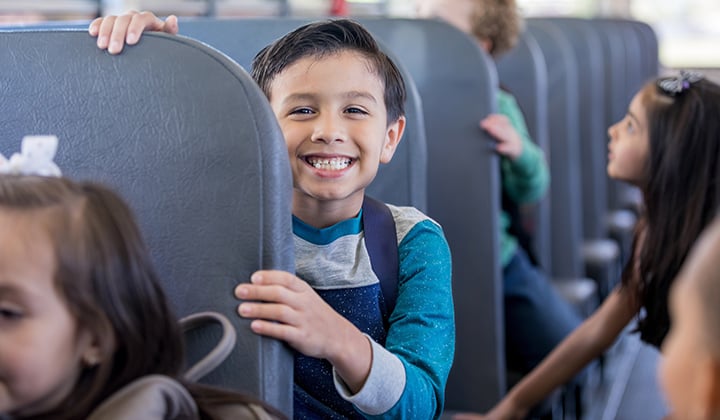By bus, by bike, by car...oh my! Get to school safely - no matter how you travel

School is back in session! Ensuring all kids make it to and from school safely is everyone’s responsibility. We recommend sitting down and speaking with your kids this back-to-school season to make sure they know and are following these safety guidelines.
School bus safety
School bus safety is important for those driving near a school bus, as well as the kiddos onboard. Safe Kids Worldwide published that in just one year, there were 76,000 illegal school bus passing violations issued in 29 states. When you’re driving near a bus, make sure to:
- Slow down and obey all marked speed limits.
- Know the meaning of the flashing colors.
- Yellow: the bus is preparing to stop
- Red: the bus has stopped, and children are getting on/off
As far as safety for the children riding the bus, teach them they should always:
- Wait for the bus to make a complete stop before stepping on or off.
- Board the bus one at a time and use the handrailing.
- Only sit 2 to a seat and face forward.
- After exiting the bus, always make eye contact with the driver before stepping into the street and NEVER walk behind the bus.
Pedestrian safety
Pedestrian safety is more than just looking both ways before crossing the street. According to Safe Kids Worldwide, approximately 16,000 kids in the United States are hit by a car each year. These tips can help keep your little ones safe if they’re heading to school by foot:
- If a child is under 10 years of age, it's recommended they hold an adult's hand when crossing the street.
- "Phones down, heads up." Put away cell phones and other technology when crossing the street.
- Be visible to drivers by wearing brightly colored clothes or wearing a reflective vest.
- Always walk on sidewalks or paths, and cross street corners marked with crosswalks or signals.
Bicycle and scooter safety
Knowing the rules of the sidewalk and being courteous of others on and near the sidewalk are just a few important safety tips while riding a bike or scooter. What you wear and how you ride are also things that need to be kept in mind.
- "Use your head, wear a helmet." Helmets are recommended any time a bike or scooter is being ridden.
- Wearing the right size of helmet that is fitted and secured can help reduce the risk of a brain injury by 88%. Follow these three steps to ensure your helmet fits properly.
- Eyes: After putting the helmet on your head, look up. You should see the bottom rim of the helmet.
- Ears: Make sure the strap forms a "V" under your ears when buckled.
- Mouth: Open your mouth as wide as you can. Does the helmet hug your head? If not, tighten the straps.
- Avoid long or loose clothing that could get caught in chains or wheel spokes.
- Proper maintenance is important! Make sure your kiddo is using the right size bike.
Motorized bike and scooter safety
Unlike regular bikes and scooters, motorized e-bikes and e-scooters are not to be ridden on the sidewalk, but in the street. The American Association of Pediatrics (AAP) states that there are 14 injuries per 100,000 trips on motorized scooters, the most common being cuts, fractures and head injuries. Make sure you are of age if riding one and keeping these tips in mind:
- AAP recommends children under the age of 16 are too young to operate or ride motorized scooters.
- Avoid wearing earbuds to be more aware of your surroundings.
- Do not text while riding and use both hands to operate the device.
- Wear close-toed shoes.
School zone safety
Research from Safe Kids Worldwide found that 1 in 3 drivers dropping off and picking up their students displayed unsafe behaviors. Do you know your school zone speed limit? How about the pick-up/drop-off policy? These are just a few things that are extremely important to know to keep school zones safe. Tips include:
- Ensure schools zones are properly marked with speed limits and loading zones.
- When dropping off or picking up your kids, avoid all cell phone use. Texting and phone calls can distract you from your surroundings.
- Be aware of distracted pedestrians. Odds are if their head is down, they too are distracted.
- Hopefully these tips help ensure your child is safe traveling to and from school and has a successful school year.
